1980s Volvo F7 gets properly restored
Posted by Chris Graham on 5th June 2024
There aren’t many Volvo F7s on the show scene, but one of the best is owned by brothers Andy and Jason Simmonds. Pip Dunn went to see it.
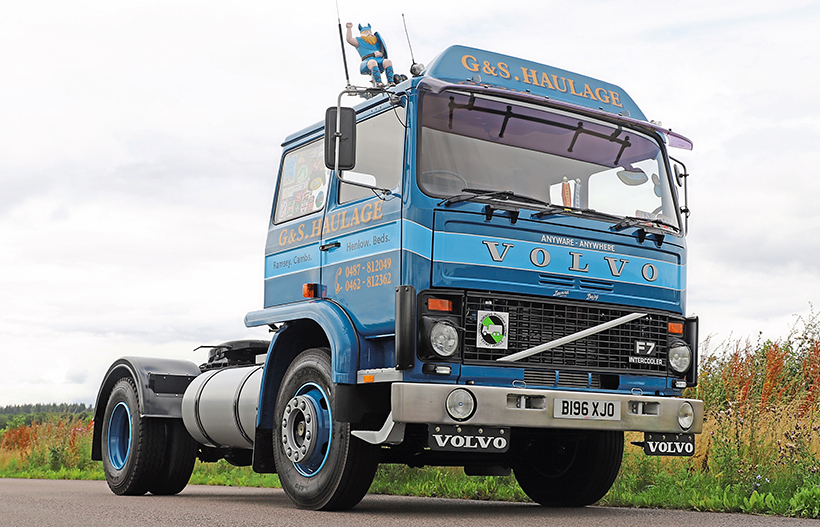
Jason Simmonds’ beautifully-restored 1980s Volvo F7.
History tells us the Volvo F7 had a very short production life, from 1979 to 1985, but in that brief period it achieved a lot. It’s one of those lorries which made British operators take note of Volvo, if they hadn’t already done so before.
It was a popular lorry, and I dare say many people, who are probably now in their 60s, passed their HGV test in one. Today, however, the F7 is relatively rare on the show scene, especially compared with its bigger F10 and F12 stablemates. That is partly because of that shorter production life but also because the bigger lorries have always been that little bit more popular for restoration.
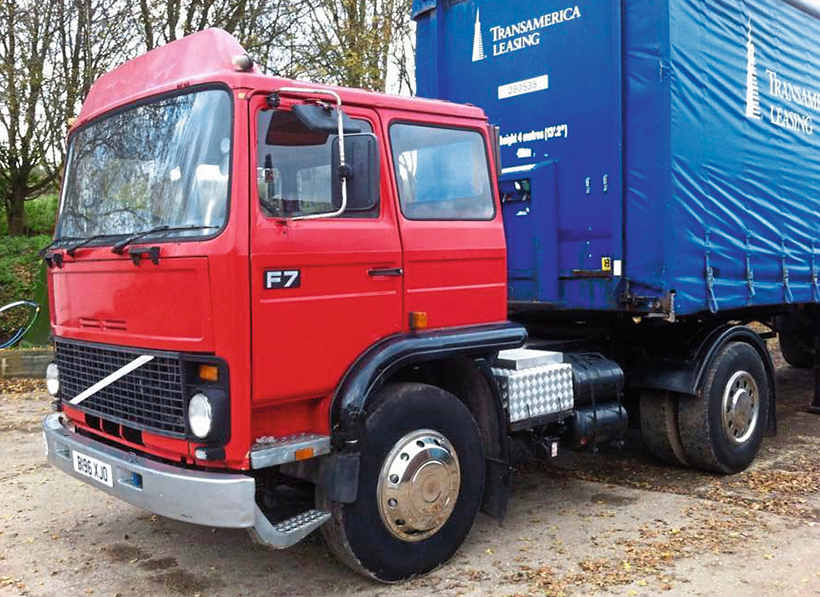
As acquired. It didn’t look too bad at first glance, but closer inspection revealed plenty of work was needed.
Anyway, one of the best preserved F7s is the 4×2 tractor owned by Andy and Jason Simmonds, and based in Henlow, and when Jason rang me to come and see his tractor unit, I jumped at the chance. You see, F7s were part of my childhood and can still remember the January 1979 edition of Truck magazine trumpeting that it had won International Truck of the Year. I still remember to this day that classic brown velour interior!
So how did the F7 come to be bought and restored? And of course, why? Says Andy: “I was sitting at home on a Sunday evening in 2012 thinking about the week ahead and the phone rings, my niece (brother’s daughter) is calling me to say ‘Dad says have a look on eBay there’s a Volvo F7 finishing soon, what do you think?’ My brother Jason had said before that he’d like an F7, but we had our hands full at the time with a 1931 Sentinel DG4 undergoing complete restoration, so weren’t really after another project.

The full strip-down is underway, with the rear axle off already.
“Anyway I had a look, as you do, and agreed it certainly looked a good basis for restoration. Jason was the top bidder, although the reserve wasn’t met. Jason made contact with the owner, Roger Pattimore from Crewkerne, and the following Sunday we went to Somerset to view the F7 and see if a deal could be done.
“On arrival at Roger’s we were shown the F7, given the keys and had a test drive around the yard.”
The B-registration tractor unit had been used to move rental trailers as part of Roger’s business, but its MoT had expired and it had been relegated to being used as a yard shunter. “We gave the lorry the once over, it ran very well most things worked, but clearly needed a complete rebuild, which would take us years of spare time and lots of hard earned cash! After we had a chat, Jason made an offer which wasn’t accepted so Roger said: ‘Go away and think about it and give me call.’ Further negotiations took place and a few days later Jason became the new owner.”
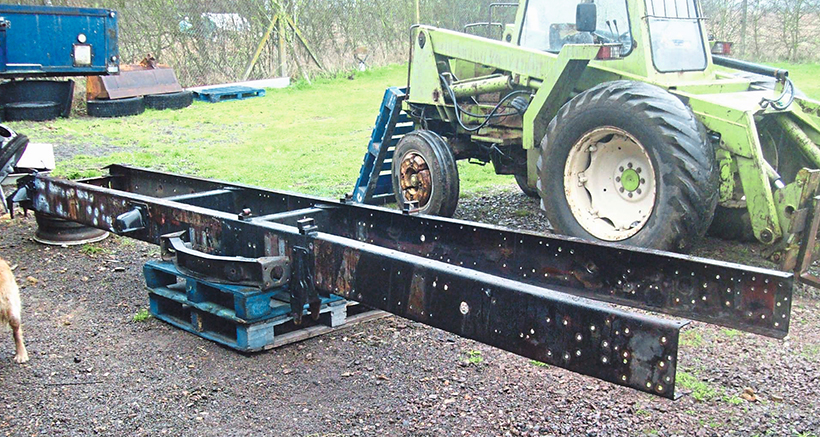
Right back to the bare chassis rails!
Why an F7? Well, like so many, Jason passed his HGV licence in one. But there was another affiliation with Volvo: “Our Dad operated 17 Volvo rigids in the 1980/90s for our haulage business and most gave us excellent service.” A more than valid reason, you could argue. Also running the restored F7 with a low loader trailer would allow Jason and Andy to transport some of the older lorries in their collection to shows further away.
Adds Andy: “Next we had the problem of getting it home, Roger said ‘leave it with me’ and a few weeks later his mate was on the way from Somerset to North Yorkshire with a low loader and had room on the trailer to drop the F7 in Bedfordshire. Once home we didn’t have enough undercover storage so it was sheeted over in our yard while we finished the Sentinel.”

Repaired cab in primer, awaiting colour coats.
When new, the F7 was intended for 32-ton work as that was the legal limit in the UK at the time. Volvo, however, considered it a 38 tonner despite its 6.7-litre straight six only producing 245bhp in its maximum form – and some were 202 or 217bhp. Jason’s is the most powerful type F7. It also has the 16-speed gearbox.
Varied career
B196 XJO was new in 1985 to Dawsons at Leighton Buzzard, and was on contract hire to Carfax pulling a car transporter trailer until 1988. It was then owned by Woodall Freight from Coleshill and it carried registration A18 WTG. After Woodhall it spent a year with Michael Coulter. Then, in 2005, it went to Market Expo of Honiton in 2005 who were exhibition contractors and sent the now 20-year-old F7 on journeys into Europe. Roger acquired it in 2006 and kept it for a further six years, until Jason bought it in 2012.
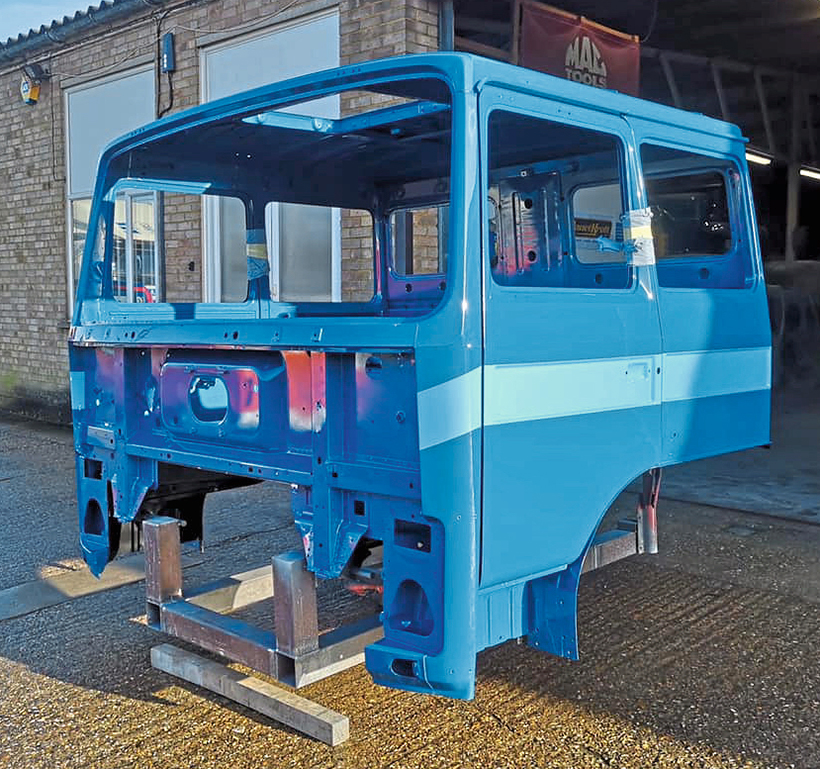
Cab in colour, and looking superb!
Apart from collecting spares, nothing was done to the F7 until the Sentinel went away in 2014 for specialist work, at which point a proper assessment could be made into the required work.
“We decided on a complete rebuild with no timescale, to try and get it to as close a new condition as possible. My 1948 Bedford was moved into a new storage shed, and the Volvo came into the workshop, where over the next two years it was completely dismantled until we were left with just a chassis frame.
“Every stage was photographed from various angles to aid rebuilding and long lists of required parts were drawn up.”
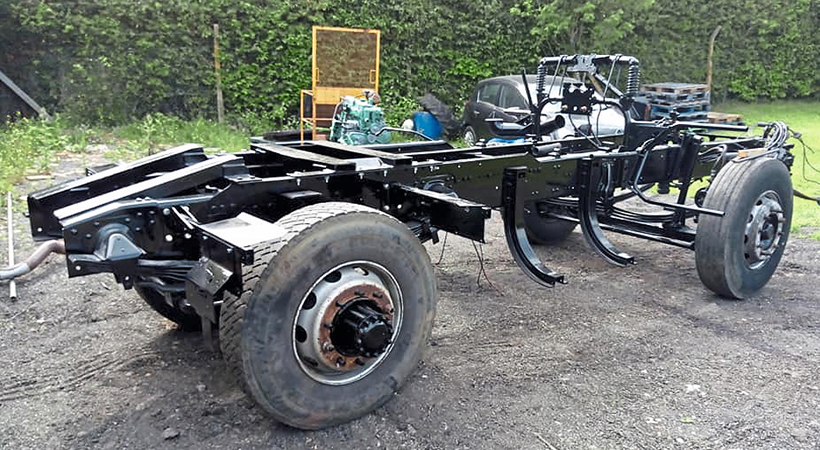
Chassis build-up underway and looking good.
The chassis required some welding and a crossmember needed straightening, after which it went away for blasting. On return it was primed and Andy and Jason spent a lot of time filling and sanding imperfections.
This was followed by fitting all the other parts that belong on the chassis such as axles, springs and so on. This was a long job and probably one of the most boring bits but as each component was fitted it was another thing off a very long list.
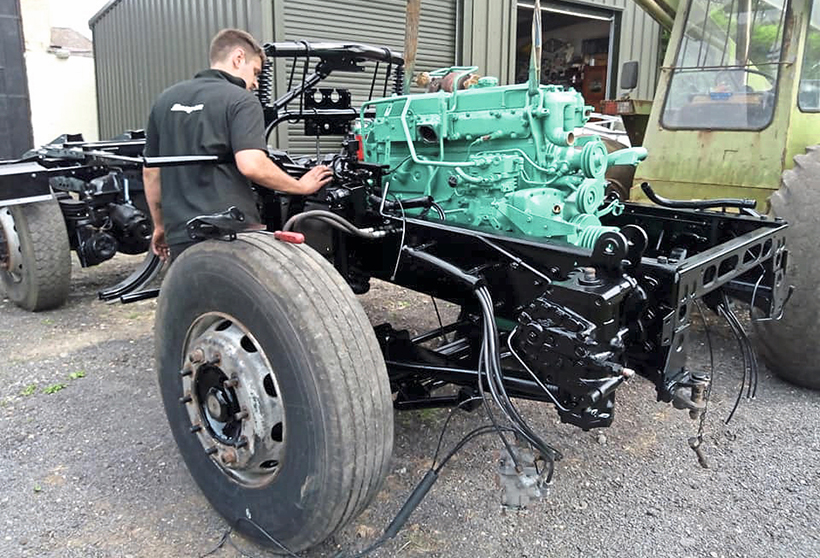
Refurbished engine back in place.
Adds Andy: “As we went along rebuilding the chassis every component was painted in the areas you don’t see so hopefully no future corrosion will appear, before the chassis received all the pipework it was sent to a friend to be given a coat of paint. When the pipework was fitted he was to have it back for the final coats, sounds simple, as our friend had done work for us before and never had any problems. However, after some time we noticed the paint bubbling and soon after that you could peel the black off the primer, so the whole chassis and components had to be stripped back again. This really set us back, and we spent many hours correcting his work and the chassis was then sent off to an Avery’s garage at Leighton Buzzard for painting.”
Getting the parts
Sourcing missing or damaged components is an ‘interesting’ part of any restoration and Jason and Andy will admit they were very lucky here, also very appreciative of the many people willing to help.
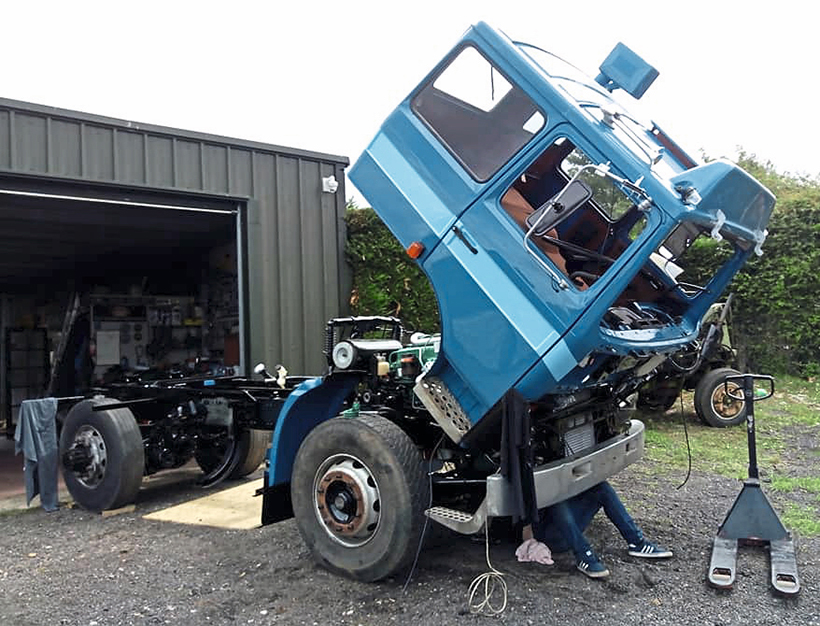
Cab back on, final fitting-up underway.
“We found two very derelict F6s and the owners were only too pleased to help, basically saying we should grab some spanners and help ourselves. One F6 was in a field full of cows, so we got used to paddling in cow manure over several visits!
“Several job lots of new F7 spares came our way, including a whole van-load from a former operator of F7s from Suffolk, a case of being in the right place at the right time. We also approached Trevor Rowell from Cambridgeshire who has a superbly restored F7 and he too was a great help with parts.”
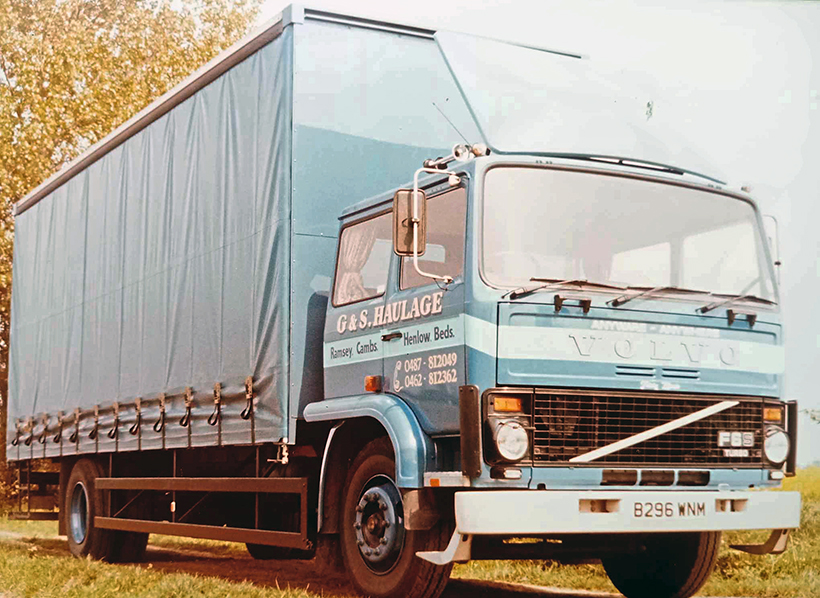
The inspiration; one of the F7s operated by G & S back in the late 1980s.
The engine was completely stripped, revealing that both cylinder heads were cracked, a common fault on F7s, which is even mentioned in the Volvo workshop manuals. So a second engine was purchased which yielded heads in good order. A set of shells were also required and a fuel pump, injectors, turbo and radiator were all refurbished and everything reassembled with new gaskets and seals. Then Andy and Jason soda-blasted several layers of paint off, resprayed it in Volvo Penta Green and refitted it to the chassis, followed by the many other components.
Restoring the cab took time as most of the floor had rotted away and the areas around the steps and bottom of the windscreen were also bad. Fortunately, the rest of the cab had survived well. Replacement doors, wings, drop wings and a front panel all had to be found and many miles were travelled to obtain these secondhand – new ones just don’t exist.

This could almost be a brochure-photo! Note the analogue tachograph.
Adds Jason: “We looked around for somebody to restore the cab as we weren’t going to use our ‘mate’ who messed the chassis up, so on a recommendation, we approached Panelkraft, a local company specialising in Volkswagen restorations. They had certainly done some fantastic jobs but had never done a lorry cab before, so took the job on as something different.”
Panelkraft made a superb job of the whole cab, which had been stripped to just the last nut and bolt before Panelkraft welded up all the holes and then blasted inside and out before returning it to Panelkraft for many hours of preparation and several coats of paint.

Lots of lovely period touches throughout the cab.
An appropriate livery
Says Andy: “The colours chosen were those of our own company and replicated a B-registered F6 sleeper cab Dad had in 1984. We carried on with numerous jobs on the chassis while the cab was away and finally got to collect the new shiny cab on Christmas Eve 2019. As keen as we were to refit the cab we didn’t do it on Christmas Day, just in case the family weren’t quite so understanding! So we opted for Boxing Day instead!
“The most useful item in our yard is a Collins Telehandler, many years old but we couldn’t do without it and this was trusted to lift the cab on, I was driving and have never been so relieved as when it was finally lowered into place, without damage!”

Classic 1980s velour and plastic around the driver!
With the cab and chassis now being reunited it was time to fit the small items which had been taken home and refurbished there. All the small bits took many hours of work, but really bring the project to life when fitted.
The interior was probably one of the more challenging areas to get back to 1985 condition.
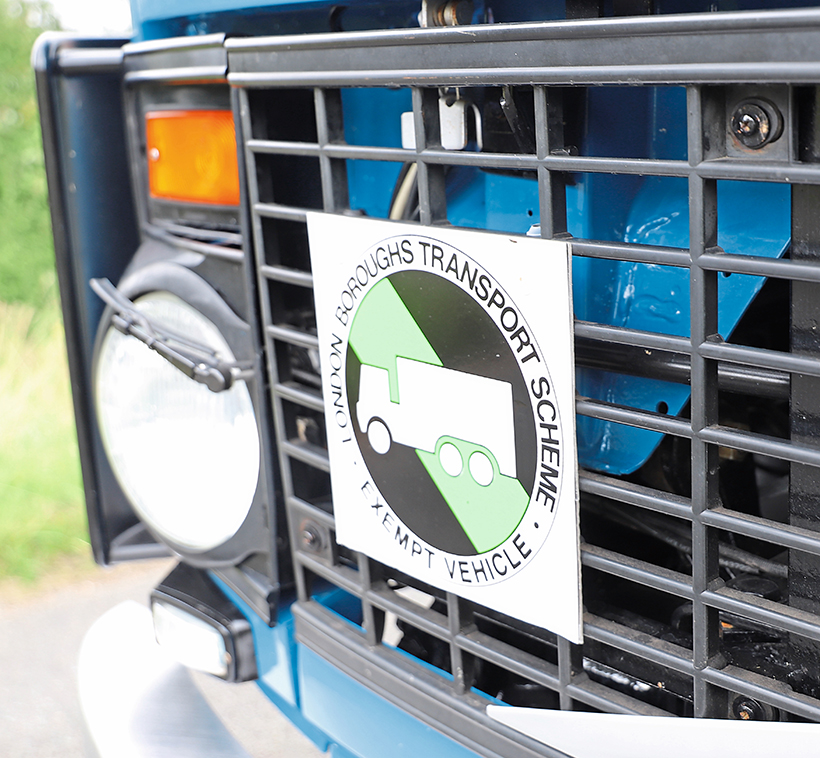
A sign of an earlier attempt to control lorry access to the capital.
Good seats and the bed came from one of the abandoned F6s that had been stripped, and lots of the small plastic fittings came from the ‘cowfield’ F6. The glass was refitted and the reupholstered headlining went in, albeit requiring three pairs of hands. But at least there was now a bed to lay on now whilst propping it up with knees!
A local haulier that used to run F7s came up with brand new mirrors, head and rear lights and lots of other items; help like this is always very much appreciated of course. As parts were fitted everything was wired up but there were several issues with the wiring, these were sorted by an auto electrician – some jobs are best tackled by the experts.
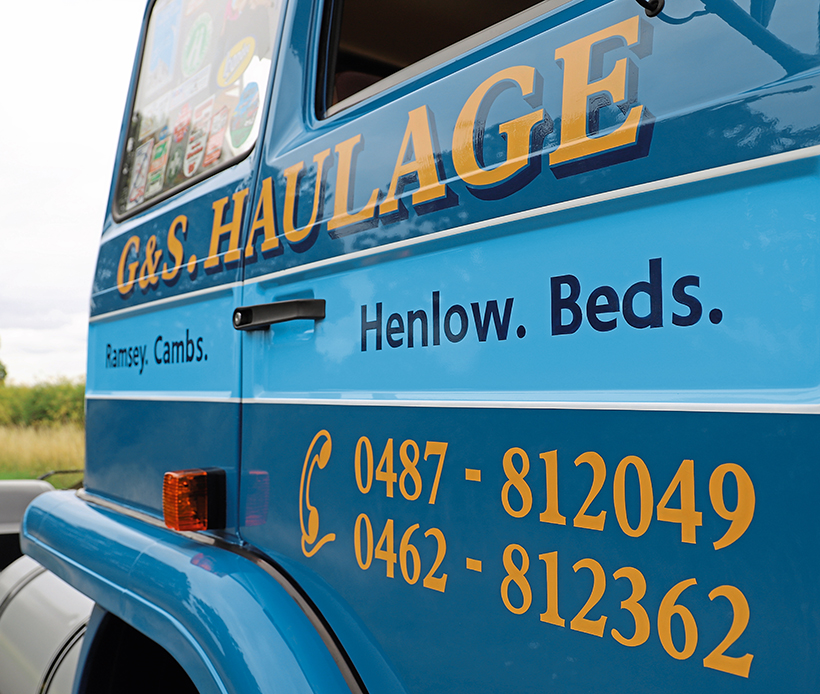
Lovely signwriting, and period four-digit phone area codes.
Eventually, the day came when it was time to connect the batteries and see if there was any life in the old lorry.
Adds Andy: “It fired up easily with not a great deal of smoke and was left ticking over for a while so we could attend to several air, water and fuel leaks and then for the moment of truth, it was put into gear and the handbrake released. Nothing seemed to happen as we discovered the rear brakes were stuck firmly on. This was followed by several days head scratching and bad language before Jason discovered some pipework had been replaced incorrectly, which once changed released the handbrake!”
The whole project was really moving on now, the cab had been signwritten, with the talented brushes of Tim Girvan replicating the Volvos Andy and Jason’s father operated in the 1980s. A correct period set of five-hole Volvo wheels took some finding, but once again with the help of friends and contacts odd ones were acquired until there were six. These were blasted and after much preparation were as good as new.
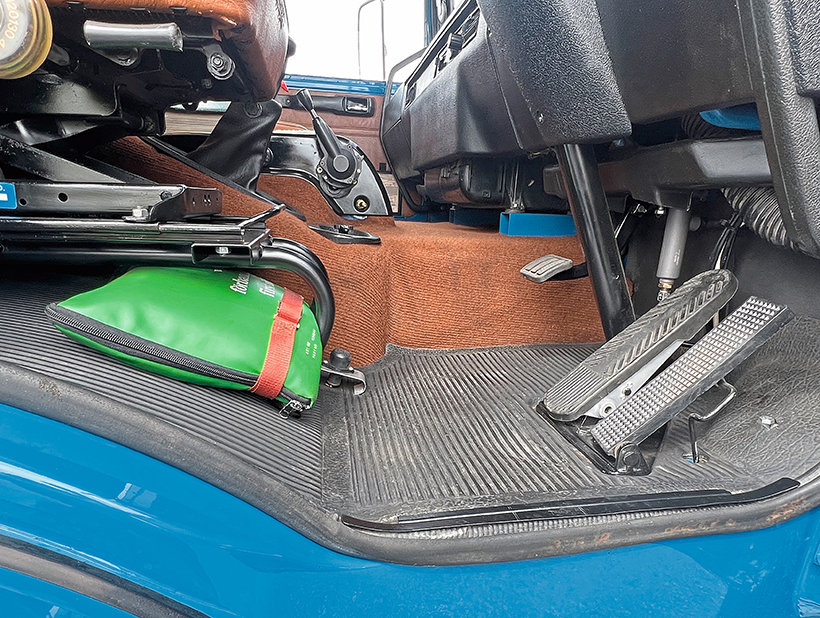
How clean is that? Again, an image that could have come from a brochure.
The final push
An MoT test was booked in April 2022. There were plenty of jobs still to do but finally the list was getting much shorter. “Prior to the test we had ran it to a testing station for a brake test with a loaded trailer and final adjustments, all seemed good and the day of the test came. Jason arrived in good time and again hooked up to the test trailer and the test nearly stopped before it had started as the tester had a look around and said: ‘I’ve never seen a chassis so clean, how are we going to proceed with my tapping hammer?’ Jason presented him with a wooden child’s hammer and asked to use that. Anyway the test was passed with no issues whatever, so we were very pleased all round.”
So did Andy and Jason enjoy the many years of hard work? “Yes! I can definitely say we did! Did we fall out? No, but we called the F7 many things that are not printable here! Would we do it again? Well never say never, but there are several other restored lorries and tractors that all need looking after and take up a lot of time.”

The next project is a 1953 Austin A40 pick-up, which the brothers had since 1978 and requires a fair amount of time before it goes back on the road. The F7 has attended several shows since completion and they have received some good comments so they would like to think that we got it right, and they can be rather proud of this lorry even if Jason’s wallet is slightly lighter now!
As a postscript, inside the F7 are a collection of period maps and A to Z books, plus a host of Volvo brochures form the period. There is a tape player – with a selection of cassettes (remember them kids?), plus a CB radio and analogue tachograph while the rear windows in the sleeper are covered with period stickers and so on.

And one thing I love to see is the correct phone numbers for the lorry’s period painted on the side, in a traditional style as well, in this case 0487 and 0462. In short, this is a wonderful restoration, and Andy and Jason can be exceptionally proud of their lovely little F7.
This feature comes from the latest issue of Classic & Vintage Commercials, and you can get a money-saving subscription to this magazine simply by clicking HERE

Previous Post
A fine collection of Roadless Fordson tractors
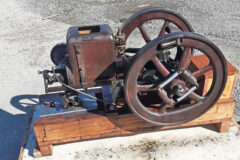
Next Post
Restoring a Nelson Brothers stationary engine



